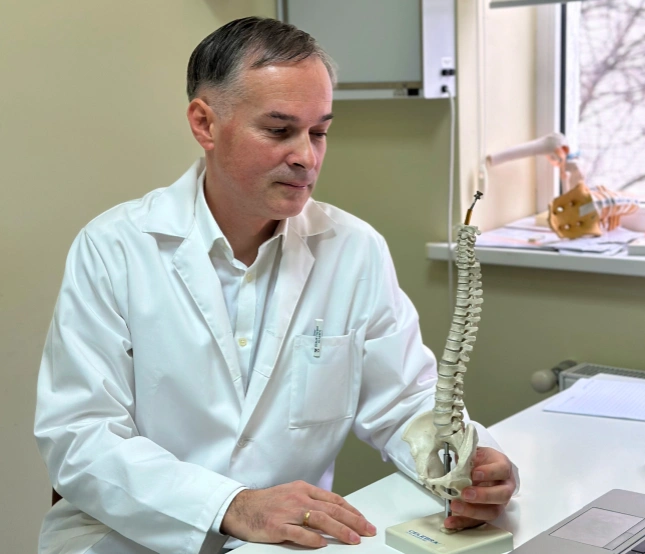Pathology of the spine

The main pathology of the spine that we operate on:
- Minimally invasive, including endoscopic interventions for herniated discs in any part of the spine;
- Stenosis of the spinal canal;
- Spondylolisthesis (displacement of vertebrae relative to each other);
- Traumatic and pathological vertebral fractures in haemangiomas, osteoporosis, myeloma and metastatic lesions.
- Neoplasms of the spine and spinal canal.
We use minimally invasive, endoscopic techniques and microsurgical equipment.
Endoscopic discectomy
- is a minimally invasive surgical operation to remove a herniated disc (a fragment of the nucleus of the intervertebral disc) from the spinal canal and release the nerve root and/or spinal cord.
Modern minimally invasive techniques allow for hernia removal through an incision of up to 10 mm, which reduces trauma to healthy tissues and shortens the rehabilitation period.
We mainly use unilateral endoscopic discectomy (UBE), which is a modern and effective method of removing hernias in the lumbar spine under general anaesthesia through 2 skin punctures up to 1 cm posteriorly.
This method of surgical treatment is the least invasive, most modern and technologically advanced.
HOW IS AN INTERVERTEBRAL HERNIA REMOVED?
Endoscopic spinal surgery is performed under general anaesthesia.
At the stage of preoperative X-ray marking, the neurosurgeon accurately determines the location of the herniated disc and makes an incision in the skin up to 10 mm. The doctor installs a working channel (a tube through which the endoscope enters). The endoscope provides excellent visual control over the course of the operation, which transmits an enlarged image to a high-resolution screen using a camera. Using special instruments with a diameter of up to 3 mm, the hernia is removed without further damage to the surrounding structures.
- minimal damage to tissues (muscles, ligaments, bone structures);
- lower rate of postoperative complications;
- frequent ability to walk 3 hours after surgery;
- aesthetic result, an excellent solution for patients with an individual predisposition to hypertrophic scars;
- discharge from the clinic the next day, the day after, or sometimes on the day of surgery;
- minimal use of painkillers after surgery.
- quick recovery and return to full life.
Decompression operations
We perform decompression surgeries to eliminate spinal canal stenoses and spondylolisthesis - if necessary, in combination with stabilising techniques (we use microsurgical techniques, minimally invasive methods, and work with modern certified implants).
Stabilising and reconstructive surgeries
We perform a wide range of stabilising and reconstructive surgeries for vertebral fractures of various etiologies (we use minimally invasive techniques and work with modern certified implants).
In particular, we often perform "vertebral cementation" - percutaneous, puncture vertebroplasty - a minimally invasive procedure under Rg control, which involves the percutaneous injection of bone cement into the damaged vertebral body and is performed under local anaesthesia. In this case, the patient is conscious during the surgery and can tell the doctor about his or her feelings.



